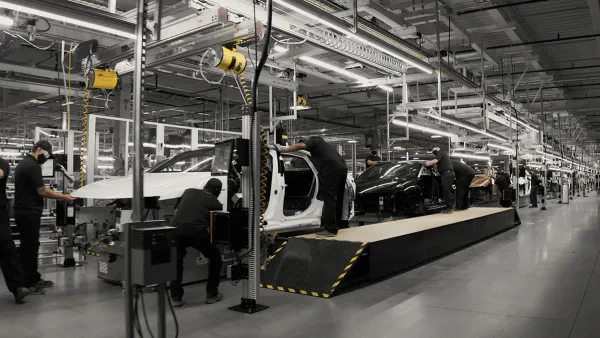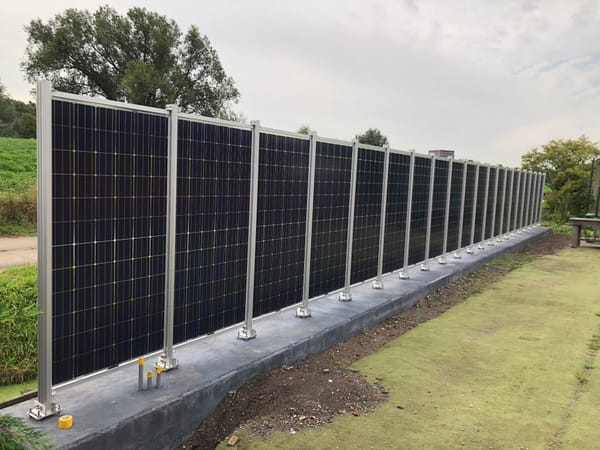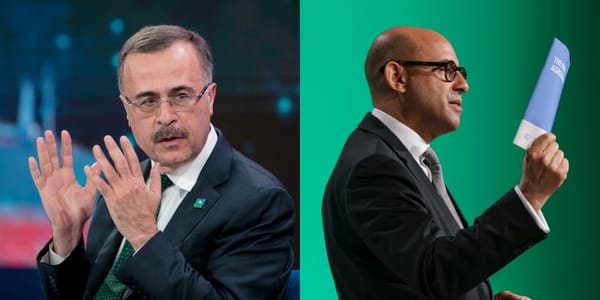The U.N. gets a bit more strident; Plans for this newsletter
Good Afternoon,
Today, I’ll dive into the biggest climate news of the day, the first release of the U.N. Global Stocktake Report, an every-five-years (“quinquennial”) report on whether carbon emissions reductions goals are being met. Short answer: Not enough.
But first, I’m going to give you an update on where this newsletter/blog-thing is going, and my larger goals for it.
-Mike
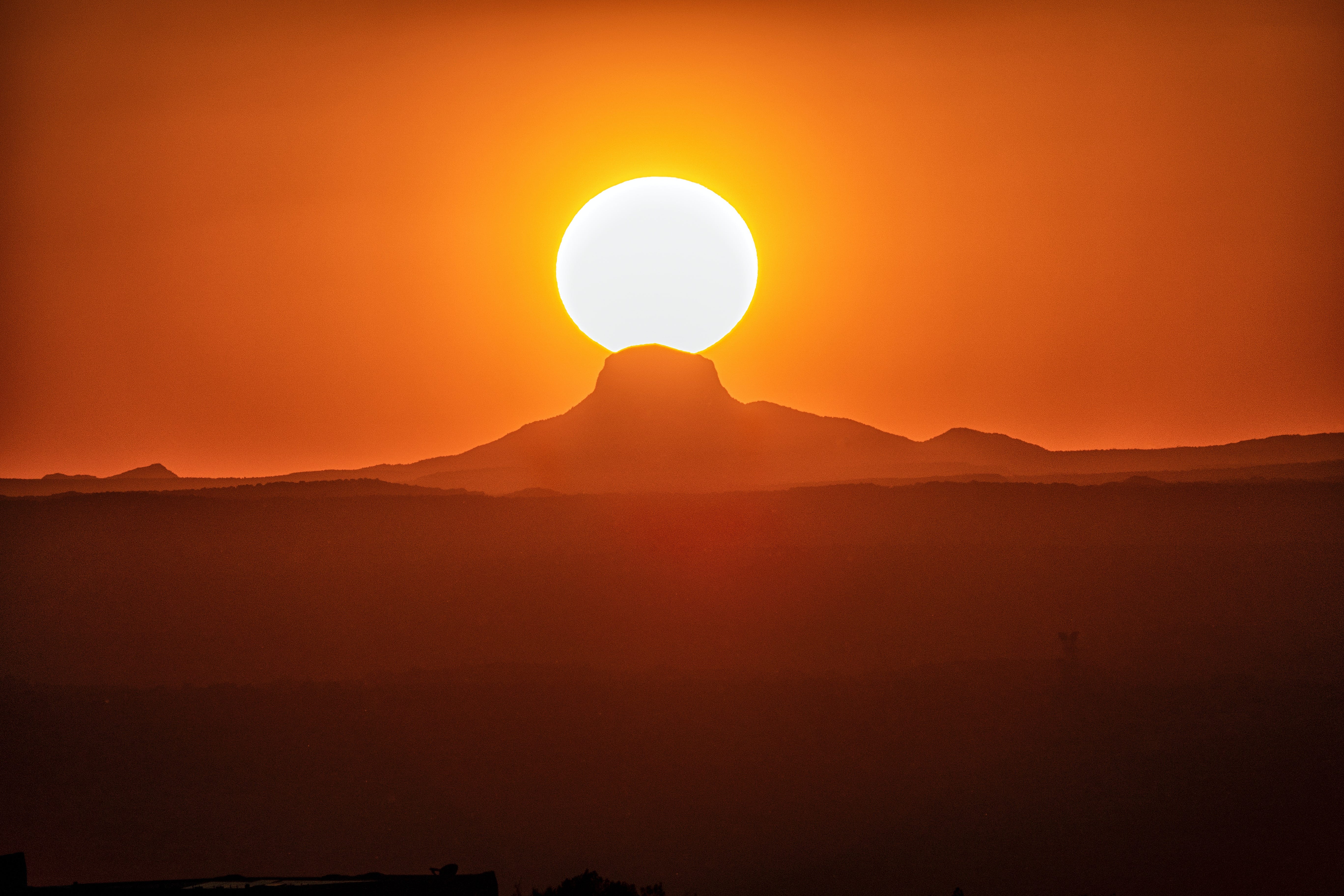
What’s Heat Rising supposed to be all about?
Let’s get this out front: There really aren’t very many subscribers to this newsletter. That’s partly by design. You, fair reader, have been part of a series of thought experiments for me, as I’ve been working out exactly what about climate I really want to focus on. Heat Rising has basically served as a research vehicle for me, an excuse to learn more about climate change and the issues surrounding it.
As such, I haven’t really made an effort to promote the newsletter, largely because when you promote something, you need to give a definitive value statement: What is it good for? I couldn’t clearly answer that question, and I wanted flexibility as I learned more and made adjustments on the fly.
When I started, I knew one thing for sure: I’m interested in climate issues and I want to do something that involves news and climate. But I wasn’t sure exactly what aspect: green technology, science explanation, as a reporter, part of an existing news organization, or something completely different altogether. Each entry I’ve written over the last six months between March and now has helped to clarify things a bit more.
Gradually, I came to the conclusion that at some point, the place where the world is going to agree on how to tackle climate will be through the U.N.’s global climate negotiations, the Framework Convention for Climate Change (UNFCCC), which has one big annual meeting, the Conference of the Parties (COP) and a half dozen smaller meetings throughout the year.
The UNFCCC meetings, I’ve concluded, are undercovered. Yes, they get plenty of general news coverage, but these reports are geared towards generalists, not people trying to figure out how to work with the UNFCCC as an attendee or an organization trying to achieve something through the meetings. There needs to be a non-aligned news organization – one that’s not operated by an advocacy group – that covers the details of the meetings: What is expected to happen, the people doing it, and where it will likely happen. As it turns out, this information is not easy to find.So, in July I started meeting with donors, foundations, and nonprofit leaders to ask for input and guidance on how I could fund such an operation. I’ve operated five different news startups, but none as a non-profit, and none with global ambitions. If I’m to make this all happen, I’m going to require a great deal of support.
The easy part for me has been figuring out how the new organization would operate and how it would seek out and build an audience. I’ve done that before. But first I need to have a rock solid idea of what the content would look like and I need to build a coalition of support for the publication. That means meeting with lots of people and lots of figuring out who are the right people to connect with.
This is the part people don’t talk about much when they’re working to launch a new thing: Laying the foundation. The reality is, unless I meet a generous benefactor soon, I’m likely many months away from launching the publication because I have a lot of foundation to lay before I can start building the structure.
For now, I have a more short-term goal: I’m planning to attend the UNFCCC meeting in Dubai this December, and hopefully some of the lead-up meetings as a freelancer. This week I acquired a media sponsor for my U.N. credentials; now I’m looking for financial sponsors to pay my way to meetings in Dubai, Panama City, and Singapore in October, November, and December.
My short-term plan is this:
- Start calling all kinds of people around the world to see what I can learn about the meetings in advance.
- Pick up a couple of freelance assignments for each meeting so I can have some kind of deadline – that always makes my brain work better.
- Network with meeting attendees with the goal of gaining a broader perspective.
- Blog about it all here, since writing is the best way I solidify ideas in my mind.
- Write some sort of report on my findings, use that to fundraise.
- Figure out next steps sometime in the new year.
That’s all pretty ambitious, but go big or go home, right?
That all means that you should expect another shift in this newsletter’s content somewhere down the line. Ultimately, this is going to be a window into the process of how I develop a new publication, as well as the climate issues I think we’re going to need to focus on.
It’s all going to be a bit of a highwire act, since there’s no guarantee a publication will launch and I will likely need to make all kinds of changes to how it comes together.
Thanks for reading. And if you like this, please tell other people about what I’m up to.
-Mike
“The window to keep limiting warming to 1.5 °C within reach is closing rapidly”
One of the major deliverables of COP28 in Dubai this December is the first Global Stocktake (GST) report, described by the U.N. as “a process for countries and stakeholders to see where they’re collectively making progress towards meeting the goals of the Paris Climate Change Agreement – and where they’re not.” After this report, countries are supposed to develop new five-year Nationally Determined Contribution (NDC) plans, and then another GST to evaluate those plans in 2028, and so-on every five years.
For those of us looking for immediate, direct action, reading these reports can be depressing, since so much of the commentary seems obvious. But another view of the reports is that consensus is extremely difficult, and the promise and struggle of mitigating global climate change is that action must be consensual if we’re going to succeed. You can’t have most of the world mitigating carbon while one small part spews GHGs in the air. The increasing stridency of reports like the Global Stocktake indicates how much closer we’re getting to consensus.
Today, in another step towards consensus, the U.N. released an advance version of the “Technical Dialogue” of the first Global Stocktake, which essentially boils down the most potent parts of what is likely to be a much more in depth report to be released later this fall. As with most U.N. documents, the most powerful stuff is buried pretty deep. From paragraph number 80:
The window to keep limiting warming to 1.5 °C within reach is closing rapidly, and progress is still inadequate based on the best available science. Global emissions to date are not in line with modelled global mitigation pathways consistent with the global temperature goal of the Paris Agreement nor are they aligned with longer-term emission reduction goals. Impacts of climate change are increasing and threaten all countries, yet adaptation efforts to date have focused on planning and have not yet driven the broad changes necessary to enhance adaptive capacity, strengthen resilience and reduce vulnerability. Losses and damages are already being experienced. Finance – international and domestic, public and private – needs to be urgently scaled up and made more effective, and much finance still flows to activities that increase GHG emissions and vulnerabilities to climate change.
And, no surprise to anyone who reads this newsletter, if we continue on the path set by NDCs, the mitigation plans each country has set as of today, we’re not going to get anywhere near stopping global warming.
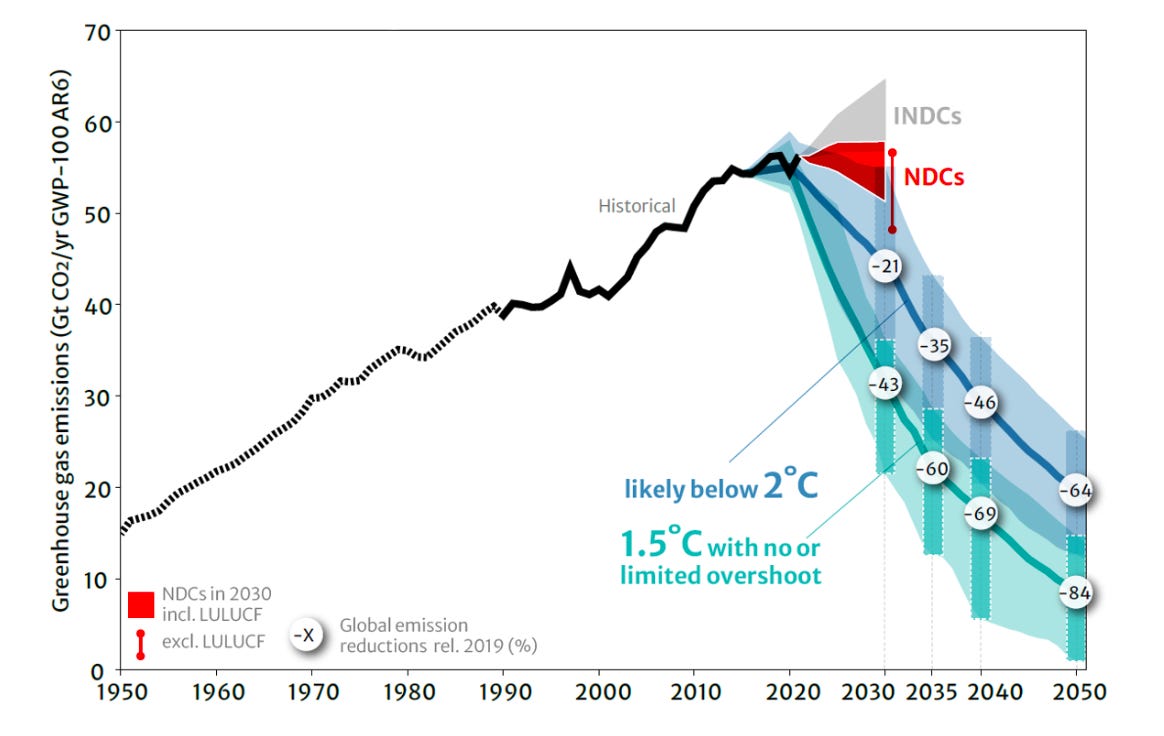
Unlike previous U.N. climate reports, this one does not merely stick to scientific evidence, it reviews the efficacy of collective pledged actions around the globe and is often prescriptive.
Gaps in collective progress on mitigation can be identified on two fronts. First, the mitigation ambition of NDCs is not collectively sufficient to achieve the Paris Agreement temperature goal. Emissions gaps are the difference between the emission levels implied by the NDCs and the average emission levels of global modelled mitigation pathways consistent with limiting warming to 1.5 °C or 2 °C. Second, implementation gaps refer to how much currently enacted policies and actions fall short of reaching stated targets and pledges. Action is needed across both gaps to increase the ambition of NDCs and the implementation of policies to achieve the stated targets, and to progress towards achieving the goals of the Paris Agreement.
The report also dives deep into the financial aspect of mitigating climate change, devoting close to a dozen pages of discussion on financial needs.
Global investment needs to meet the goals of the Paris Agreement are in the order of trillions of United States dollars. Accelerated action is required to scale up climate finance from all sources beyond the mobilization and provision of support from developed to developing countries
It doesn’t make specific recommendations, but the document essentially sets the agenda for this fall’s negotiations, making it impossible to avoid the topic, which the most developed countries, known as “Annex I” parties, have been attempting to avoid.
The report also mentions phasing out fossil fuels no less than nine-times, “To achieve rapid reductions in emissions, the phase-out of unabated fossil fuels is required”, ensuring that discussions will likely begin this year for setting a global phase out.
A relatively readable 41 pages, the first Global Stocktake Report is likely to become a major pivot point in negotiations this December as well as a hopeful encouragement for countries to set stronger NDCs for the next five years.
Other Things Happened
- Some positive charts about the fight against climate change.
- Science now suggests that forests are full. They can no longer absorb all the carbon-dioxide we create, and rising global temperatures make them more likely to burn, releasing even more carbon.
- Lots of news from the U.N. African Climate Summit that finished yesterday. Africans proposed a global carbon tax, The EU proposed a global carbon credit system, and Kenya says climate can’t be fixed until global debt levels are reduced.
- Indians are hoping their hosting of this weekend’s G20 summit will bring a climate agreement breakthrough. But Saudi Arabia is against it and China’s leader is skipping it.
You made it to the bottom of the newsletter! The Tesla CyberSpoon is real, but only available in China.



